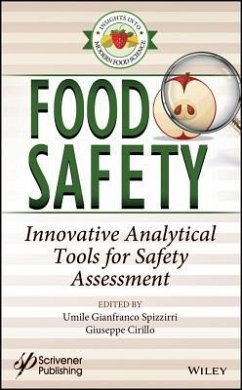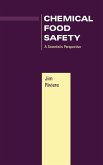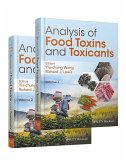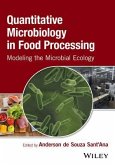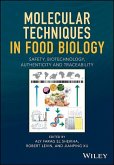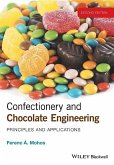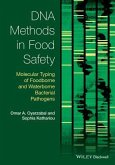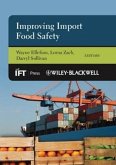Food Safety
Innovative Analytical Tools for Safety Assessment
Herausgeber: Spizzirri, Umile Gianfranco; Cirillo, Giuseppe
Food Safety
Innovative Analytical Tools for Safety Assessment
Herausgeber: Spizzirri, Umile Gianfranco; Cirillo, Giuseppe
- Gebundenes Buch
- Merkliste
- Auf die Merkliste
- Bewerten Bewerten
- Teilen
- Produkt teilen
- Produkterinnerung
- Produkterinnerung
Food safety and quality are key objectives for food scientists and industries all over the world. To achieve this goal, several analytical techniques (based on both destructive detection and nondestructive detection) have been proposed to fit the government regulations. The book aims to cover all the analytical aspects of the food quality and safety assessment. For this purpose, the volume describes the most relevant techniques employed for the determination of the major food components (e.g. protein, polysaccharides, lipds, vitamins, etc.), with peculiar attention to the recent development in…mehr
Andere Kunden interessierten sich auch für
![Chemical Food Safety Chemical Food Safety]() Jim E RiviereChemical Food Safety137,99 €
Jim E RiviereChemical Food Safety137,99 €![Analysis of Food Toxins and Toxicants, 2 Volume Set Analysis of Food Toxins and Toxicants, 2 Volume Set]() Analysis of Food Toxins and Toxicants, 2 Volume Set321,99 €
Analysis of Food Toxins and Toxicants, 2 Volume Set321,99 €![Quantitative Microbiology in Food Processing Quantitative Microbiology in Food Processing]() Quantitative Microbiology in Food Processing263,99 €
Quantitative Microbiology in Food Processing263,99 €![Molecular Techniques in Food Biology Molecular Techniques in Food Biology]() Molecular Techniques in Food Biology223,99 €
Molecular Techniques in Food Biology223,99 €![Confectionery and Chocolate Engineering Confectionery and Chocolate Engineering]() Ferenc A MohosConfectionery and Chocolate Engineering287,99 €
Ferenc A MohosConfectionery and Chocolate Engineering287,99 €![DNA Methods in Food Safety DNA Methods in Food Safety]() DNA Methods in Food Safety201,99 €
DNA Methods in Food Safety201,99 €![Improving Import Food Safety Improving Import Food Safety]() Improving Import Food Safety257,99 €
Improving Import Food Safety257,99 €-
-
-
Food safety and quality are key objectives for food scientists and industries all over the world. To achieve this goal, several analytical techniques (based on both destructive detection and nondestructive detection) have been proposed to fit the government regulations. The book aims to cover all the analytical aspects of the food quality and safety assessment. For this purpose, the volume describes the most relevant techniques employed for the determination of the major food components (e.g. protein, polysaccharides, lipds, vitamins, etc.), with peculiar attention to the recent development in the field. Furthermore, the evaluation of the risk associated with food consumption is performed by exploring the recent advances in the detection of the key food contaminants (e.g. biogenic amines, pesticides, toxins, etc.). Chapters tackle such subject as: * GMO Analysis Methods in Food * Current Analytical Techniques for the Analysis of Food Lipids * Analytical Methods for the Analysis of Sweeteners in Food * Analytical Methods for Pesticides Detection in Foodstuffs * Food and Viral Contamination * Application of Biosensors to Food Analysis
Hinweis: Dieser Artikel kann nur an eine deutsche Lieferadresse ausgeliefert werden.
Hinweis: Dieser Artikel kann nur an eine deutsche Lieferadresse ausgeliefert werden.
Produktdetails
- Produktdetails
- Verlag: Wiley
- Seitenzahl: 480
- Erscheinungstermin: 19. Dezember 2016
- Englisch
- Abmessung: 231mm x 155mm x 30mm
- Gewicht: 748g
- ISBN-13: 9781119160557
- ISBN-10: 1119160553
- Artikelnr.: 46007990
- Herstellerkennzeichnung
- Libri GmbH
- Europaallee 1
- 36244 Bad Hersfeld
- gpsr@libri.de
- Verlag: Wiley
- Seitenzahl: 480
- Erscheinungstermin: 19. Dezember 2016
- Englisch
- Abmessung: 231mm x 155mm x 30mm
- Gewicht: 748g
- ISBN-13: 9781119160557
- ISBN-10: 1119160553
- Artikelnr.: 46007990
- Herstellerkennzeichnung
- Libri GmbH
- Europaallee 1
- 36244 Bad Hersfeld
- gpsr@libri.de
Umile Gianfranco Spizzirri obtained his PhD in Development of Molecules of Pharmaceutical Interest in 2005 from the University of Calabria. He is currently a member of the Technical Staff at the Department of Pharmacy, Nutrition and Health Science of the same University. His research activities are mainly related to the polymer chemistry and technology for the preparation of stimuli-responsive drug delivery system, functional polymers for food industry, and new analytical methodologies for the food quality and safety assessment. He is author and co-author of more than 100 publications, including research and review article as well as invited book chapters. Giuseppe Cirillo received his PhD in "Methodologies for the Development of Molecules of Pharmaceutical Interest" in 2008 from the University of Calabria Italy. He is currently is in a post-doctoral position at the same University. His research interests are in the development of functional polymers with tailored biological activity (antioxidant, antimicrobial, anticancer, chelating), the design of smart hydrogels for drug delivery, the study of the activity of innovative functional foods and nutraceuticals, and the synthesis and functionalization of carbon nanotubes-based devices for biomedical applications. He is author and co-author more than 100 publications, including research and review article as well as invited book chapters.
Preface xiii 1 Food Analysis: A Brief Overview 1 Giuseppe Cirillo, Donatella Restuccia, Manuela Curcio, Francesca Iemma and Umile Gianfranco Spizzirri 1.1 Introduction 1 1.2 Chromatographic Techniques in Food Analysis 2 1.3 Spectroscopic Methods 5 1.4 Biologically Based Methodologies in Food Analysis 7 References 8 2 Recent Analytical Methods for the Analysis of Sweeteners in Food: A Regulatory Perspective 13 Romina Shah and Lowri S. De Jager 2.1 Introduction 13 2.2 Sample Preparation 17 2.2.1 Internal Standards 20 2.3 Analytical Methods 21 2.3.1 Instrumental Analyses 21 2.3.1.1 HPLC-UV-VIS/DAD/ELSD Detection 21 2.3.1.2 HPLC-MS/Tandem MS Detection 24 2.3.1.3 Capillary Electrophoresis 28 2.4 Future Trends 28 References 29 3 Current Analytical Techniques for Food Lipids 33 Cynthia T. Srigley and Magdi M. Mossoba 3.1 Introduction 33 3.2 Official Methods for the Analysis of Fat in Foods 36 3.2.1 Importance of Official Methods of Analysis 36 3.2.2 Official Methods for the Gravimetric Determination of Total Fat 36 3.2.2.1 Solvent Extraction Procedures 37 3.2.2.2 Hydrolytic Procedures 40 3.2.3 Official Methods for the Determination of Total Fat by GC 42 3.2.3.1 Sample Preparation Procedures 42 3.2.3.2 Analysis of FAME by GC-FID 47 3.2.4 FTIR Spectroscopic Methods 51 3.2.5 Method Validation for Novel Sample Matrices 54 3.3 Conclusions 56 References 57 4 Detection of Allergenic Proteins in Food: Analytical Methods 65 Girdhari M. Sharma, Sefat E Khuda, Christine H. Parker, Anne C. Eischeid and Marion Pereira 4.1 Introduction 65 4.2 Immunochemical Methods 69 4.2.1 Lateral Flow Device (LFD)/Dipstick 69 4.2.2 ELISA 70 4.2.2.1 Milk 71 4.2.2.2 Egg 72 4.2.2.3 Fish 72 4.2.2.4 Crustacean Shellfish 73 4.2.2.5 Peanut 73 4.2.2.6 Tree Nuts 74 4.2.2.7 Wheat (Gluten) 75 4.2.2.8 Soy 76 4.3 Mass Spectrometry (MS) Methods 76 4.3.1 Milk 81 4.3.2 Egg 82 4.3.3 Fish and Crustacean Shellfish 82 4.3.4 Peanut 83 4.3.5 Tree Nuts 83 4.3.6 Wheat 84 4.3.7 Soy 84 4.4 DNA-Based Methods 85 4.4.1 Tree Nuts 89 4.4.2 Crustacean Shellfish 90 4.5 Method Validation 90 4.5.1 Specificity and Cross-Reactivity 97 4.5.2 Robustness and Ruggedness 97 4.5.3 Sensitivity, LOD and LOQ 97 4.5.4 Accuracy and Trueness 98 4.5.5 Precision 98 References 99 5 GMO Analysis Methods for Food: From Today to Tomorrow 123 Özgür Çak
r, Sinan Meriç and
ule Ar
5.1 Introduction 124 5.2 Methods for Detection, Identification and Quantification of GMOs in Food 135 5.2.1 Detection of GMOs by DNA-Based Methods 136 5.2.1.1 Polymerase Chain Reaction for GMO Detection 138 5.2.1.2 Real-Time PCR for GMO Quantification 140 5.2.2 Protein-Based Methods for GMO Detection and Quantification 141 5.2.2.1 ELISA (Enzyme-Linked Immunosorbent Assay) 142 5.2.2.2 Lateral Flow Strips 143 5.2.3 Phenotypic Detection of GMOs 144 5.2.4 Overall Assessment of Conventional Methods 145 5.2.5 New Detection Methods of GMOs 145 5.2.5.1 Amplification Based Detection Methods of GMOs 145 5.2.5.2 Biosensor-Based Detection Methods of GMOs 151 5.2.5.3 High-Throughput (HT) Techniques for GMO Detection 154 5.3 Conclusion 160 References 163 6 Determination of Antioxidant Compounds in Foodstuff 179 Amilcar L. Antonio, Eliana Pereira, José Pinela, Sandrina Heleno, Carla Pereira and Isabel C.F.R. Ferreira 6.1 Introduction 179 6.2 Common Antioxidants in Foodstuff 180 6.3 Antioxidants for Bioactive or Preservative Purposes 184 6.4 Analysis of Antioxidants in Foods 190 6.4.1 Extraction of Antioxidant Compounds 190 6.4.1.1 Conventional Methods 192 6.4.1.2 Nonconventional Methods 192 6.4.1.3 Extraction Solvents and Surfactants 196 6.4.2 Analytical Methodologies for Antioxidants 197 6.4.2.1 Detection of Antioxidant Compounds 197 6.4.2.2 Determination of Individual Antioxidant Molecules 198 6.5 Conclusion 202 References 203 7 Analytical Methods for Pesticide Detection in Foodstuffs 221 S. Hrouzková 7.1 Introduction 221 7.1.1 Pesticide Residues in Foodstuffs 223 7.1.2 Analytical Methods for Pesticide Residue Analysis 224 7.2 Sample Preparation 225 7.2.1 Solvent-Based Extractions - Liquid-Liquid Extraction (LLE) 227 7.2.1.1 QuEChERS Extraction 227 7.2.1.2 Accelerated Solvent Extraction 229 7.2.1.3 Microwave-Assisted Extraction (MAE) 230 7.2.1.4 Supercritical Fluid Extraction (SFE) 231 7.2.1.5 Liquid Phase Microextraction (LPME) 232 7.2.2 Sorption-Based Extractions 234 7.2.2.1 Solid-Phase Extraction (SPE) 234 7.2.2.2 Matrix Solid-Phase Dispersion (MSPD) 238 7.2.2.3 Microextraction by Packed Syringe (MEPS) 238 7.2.2.4 Solid-Phase Microextraction (SPME) 239 7.2.2.5 Stir-Bar SorptiveExtraction (SBSE) 240 7.3 Chromatographic Methods 241 7.3.1 Gas Chromatography 242 7.3.2 Fast Gas Chromatography 243 7.3.3 Liquid Chromatography 244 7.4 Detection of Pesticides 245 7.4.1 MS Detection 246 7.4.1.1 Ionization Techniques in GC-MS 246 7.4.1.2 Ionization Interfaces in LC-MS 247 7.4.1.3 MS Analyzers and Tandem MS 248 7.4.2 Ambient MS 250 7.5 Specific Problems of Pesticide Residue Analysis 252 7.6 Future Trends and Conclusions 254 Acknowledgment 254 References 255 8 Application of Chromatograpic Methods for Identification of Biogenic Amines in Foods of Animal Origin 271 César Aquiles Lázaro De La Torre and Carlos Adam Conte-Junio 8.1 Biogenic Amines 272 8.1.1 Definition 272 8.1.2 Classification 272 8.1.3 Synthesis 272 8.2 Importance of Biogenic Amines in Food of Animal Origin 273 8.2.1 Toxicological Aspect 274 8.2.2 Quality Indicators 275 8.2.3 Control and Prevention 276 8.3 Procedures for Chromatographic Methods in Biogenic Amines 277 8.3.1 Sample Processing 278 8.3.2 Analytical Determination 286 8.4 Chromatography Applications in Food of Animal Origin 288 8.4.1 Milk and Dairy Products 289 8.4.2 Fish and Seafood Products 291 8.4.3 Meat, Meat Products and Edible Byproducts 292 8.4.4 Chicken Meat and Chicken Meat Products 293 8.4.5 Eggs and Egg Products 293 8.4.6 Honey 294 8.5 Conclusion 294 Acknowledgments 295 References 295 9 Advances in Food Allergen Analysis 305 Joana Costa, Telmo J.R. Fernandes, Caterina Villa, M. Beatriz P.P. Oliveira and Isabel Mafra 9.1 Introduction 305 9.2 Proteins versus DNA as Targets for Food Allergen Analysis 307 9.2.1 Protein-Based Methods 308 9.2.1.1 ELISA 308 9.2.1.2 Immunosensors 310 9.2.1.3 MS Platforms 321 9.2.2 DNA-Based Techniques 332 9.2.2.1 Real-Time PCR Coupled to HRM Analysis 332 9.2.2.2 Single-Tube Nested Real-Time PCR 333 9.2.2.3 Ligation-Dependent Probe Amplification 337 9.2.2.4 Genosensors 338 9.2.3 Aptasensors 343 9.3 Final Remarks 343 Acknowledgments 346 References 347 10 Food and Viral Contamination: Analytical Methods 361 Gloria Sánchez 10.1 Introduction 361 10.1.1 Virus Extraction from Food 364 10.1.2 Virus Extraction from Bilvalve Molluscs 364 10.1.3 Virus Extraction from Soft Fruits and Leafy Greens 367 10.1.4 Virus Extraction from Bottled Water 371 10.1.5 Virus Extraction from Other Food Products 373 10.2 Nucleic Acid Extraction and Purification 374 10.3 Virus Detection by Molecular Techniques 374 10.4 Assessment of Infectivity 376 10.5 Quality Controls 378 10.6 Conclusions 379 Acknowledgments 380 References 380 11 Application of Biosensors for Food Analysis 395 Viviana Scognamiglio, Amina Antonacci, Maya D. Lambreva, Fabiana Arduini, Giuseppe Palleschi, Simona C. Litescu, Udo Johanningmeier and Giuseppina Rea 11.1 The Agrifood Sector 396 11.2 Food Quality and Safety Concepts 397 11.3 Effect of Unsafe Food on Human Health 400 11.4 Revealing Methods for Food Components and Contaminants 402 11.5 Biosensors: Definition, Market and Application Fields 403 11.6 Biosensors and Bioassays for the Detection of Food Components and Contaminants 405 11.6.1 Biosensing Technologies for Glucose Detection 405 11.6.2 Biosensors and Bioassays to Reveal Glutamine 409 11.6.3 Biodetecting Methods for Gliadin 410 11.6.4 Enzyme Based-Biosensors for Phenols Detection 412 11.6.5 Biosensing Technology Trends for Pesticide Monitoring 414 11.6.6 Toxin Biodetection 419 11.6.7 Heavy Metal Monitoring by Biosensing Methodologies 420 11.7 Biosensors for Intelligent Food Packaging 422 11.8 Biosensor Technology to Sustain Precision Farming 423 11.9 Conclusions 424 Acknowledgments 426 References 426 12 Immunoassay Methods in Food Analysis 435 Pranav Tripathi, Satish Malik and Seema Nara 12.1 Introduction 436 12.2 Immunoassays 437 12.2.1 Principle and Significance of ELISA 438 12.2.2 Application of Immunoassays in Food Safety 439 12.3 Immunosensors 440 12.3.1 Electrochemical Transducers 441 12.3.1.1 Amperometric Transducers 441 12.3.1.2 Potentiometric Transducers 441 12.3.2 Piezoelectric Immunosensors 441 12.3.3 Optical Transducers 442 12.3.4 Application of Immunosensors in Food Safety 442 12.4 Lateral Flow Immunoassay (LFIA) 443 12.4.1 Applications of LFIA in Food Safety 444 12.5 Sample Processing in Food Analysis 445 12.6 Outlook 446 References 450
r, Sinan Meriç and
ule Ar
5.1 Introduction 124 5.2 Methods for Detection, Identification and Quantification of GMOs in Food 135 5.2.1 Detection of GMOs by DNA-Based Methods 136 5.2.1.1 Polymerase Chain Reaction for GMO Detection 138 5.2.1.2 Real-Time PCR for GMO Quantification 140 5.2.2 Protein-Based Methods for GMO Detection and Quantification 141 5.2.2.1 ELISA (Enzyme-Linked Immunosorbent Assay) 142 5.2.2.2 Lateral Flow Strips 143 5.2.3 Phenotypic Detection of GMOs 144 5.2.4 Overall Assessment of Conventional Methods 145 5.2.5 New Detection Methods of GMOs 145 5.2.5.1 Amplification Based Detection Methods of GMOs 145 5.2.5.2 Biosensor-Based Detection Methods of GMOs 151 5.2.5.3 High-Throughput (HT) Techniques for GMO Detection 154 5.3 Conclusion 160 References 163 6 Determination of Antioxidant Compounds in Foodstuff 179 Amilcar L. Antonio, Eliana Pereira, José Pinela, Sandrina Heleno, Carla Pereira and Isabel C.F.R. Ferreira 6.1 Introduction 179 6.2 Common Antioxidants in Foodstuff 180 6.3 Antioxidants for Bioactive or Preservative Purposes 184 6.4 Analysis of Antioxidants in Foods 190 6.4.1 Extraction of Antioxidant Compounds 190 6.4.1.1 Conventional Methods 192 6.4.1.2 Nonconventional Methods 192 6.4.1.3 Extraction Solvents and Surfactants 196 6.4.2 Analytical Methodologies for Antioxidants 197 6.4.2.1 Detection of Antioxidant Compounds 197 6.4.2.2 Determination of Individual Antioxidant Molecules 198 6.5 Conclusion 202 References 203 7 Analytical Methods for Pesticide Detection in Foodstuffs 221 S. Hrouzková 7.1 Introduction 221 7.1.1 Pesticide Residues in Foodstuffs 223 7.1.2 Analytical Methods for Pesticide Residue Analysis 224 7.2 Sample Preparation 225 7.2.1 Solvent-Based Extractions - Liquid-Liquid Extraction (LLE) 227 7.2.1.1 QuEChERS Extraction 227 7.2.1.2 Accelerated Solvent Extraction 229 7.2.1.3 Microwave-Assisted Extraction (MAE) 230 7.2.1.4 Supercritical Fluid Extraction (SFE) 231 7.2.1.5 Liquid Phase Microextraction (LPME) 232 7.2.2 Sorption-Based Extractions 234 7.2.2.1 Solid-Phase Extraction (SPE) 234 7.2.2.2 Matrix Solid-Phase Dispersion (MSPD) 238 7.2.2.3 Microextraction by Packed Syringe (MEPS) 238 7.2.2.4 Solid-Phase Microextraction (SPME) 239 7.2.2.5 Stir-Bar SorptiveExtraction (SBSE) 240 7.3 Chromatographic Methods 241 7.3.1 Gas Chromatography 242 7.3.2 Fast Gas Chromatography 243 7.3.3 Liquid Chromatography 244 7.4 Detection of Pesticides 245 7.4.1 MS Detection 246 7.4.1.1 Ionization Techniques in GC-MS 246 7.4.1.2 Ionization Interfaces in LC-MS 247 7.4.1.3 MS Analyzers and Tandem MS 248 7.4.2 Ambient MS 250 7.5 Specific Problems of Pesticide Residue Analysis 252 7.6 Future Trends and Conclusions 254 Acknowledgment 254 References 255 8 Application of Chromatograpic Methods for Identification of Biogenic Amines in Foods of Animal Origin 271 César Aquiles Lázaro De La Torre and Carlos Adam Conte-Junio 8.1 Biogenic Amines 272 8.1.1 Definition 272 8.1.2 Classification 272 8.1.3 Synthesis 272 8.2 Importance of Biogenic Amines in Food of Animal Origin 273 8.2.1 Toxicological Aspect 274 8.2.2 Quality Indicators 275 8.2.3 Control and Prevention 276 8.3 Procedures for Chromatographic Methods in Biogenic Amines 277 8.3.1 Sample Processing 278 8.3.2 Analytical Determination 286 8.4 Chromatography Applications in Food of Animal Origin 288 8.4.1 Milk and Dairy Products 289 8.4.2 Fish and Seafood Products 291 8.4.3 Meat, Meat Products and Edible Byproducts 292 8.4.4 Chicken Meat and Chicken Meat Products 293 8.4.5 Eggs and Egg Products 293 8.4.6 Honey 294 8.5 Conclusion 294 Acknowledgments 295 References 295 9 Advances in Food Allergen Analysis 305 Joana Costa, Telmo J.R. Fernandes, Caterina Villa, M. Beatriz P.P. Oliveira and Isabel Mafra 9.1 Introduction 305 9.2 Proteins versus DNA as Targets for Food Allergen Analysis 307 9.2.1 Protein-Based Methods 308 9.2.1.1 ELISA 308 9.2.1.2 Immunosensors 310 9.2.1.3 MS Platforms 321 9.2.2 DNA-Based Techniques 332 9.2.2.1 Real-Time PCR Coupled to HRM Analysis 332 9.2.2.2 Single-Tube Nested Real-Time PCR 333 9.2.2.3 Ligation-Dependent Probe Amplification 337 9.2.2.4 Genosensors 338 9.2.3 Aptasensors 343 9.3 Final Remarks 343 Acknowledgments 346 References 347 10 Food and Viral Contamination: Analytical Methods 361 Gloria Sánchez 10.1 Introduction 361 10.1.1 Virus Extraction from Food 364 10.1.2 Virus Extraction from Bilvalve Molluscs 364 10.1.3 Virus Extraction from Soft Fruits and Leafy Greens 367 10.1.4 Virus Extraction from Bottled Water 371 10.1.5 Virus Extraction from Other Food Products 373 10.2 Nucleic Acid Extraction and Purification 374 10.3 Virus Detection by Molecular Techniques 374 10.4 Assessment of Infectivity 376 10.5 Quality Controls 378 10.6 Conclusions 379 Acknowledgments 380 References 380 11 Application of Biosensors for Food Analysis 395 Viviana Scognamiglio, Amina Antonacci, Maya D. Lambreva, Fabiana Arduini, Giuseppe Palleschi, Simona C. Litescu, Udo Johanningmeier and Giuseppina Rea 11.1 The Agrifood Sector 396 11.2 Food Quality and Safety Concepts 397 11.3 Effect of Unsafe Food on Human Health 400 11.4 Revealing Methods for Food Components and Contaminants 402 11.5 Biosensors: Definition, Market and Application Fields 403 11.6 Biosensors and Bioassays for the Detection of Food Components and Contaminants 405 11.6.1 Biosensing Technologies for Glucose Detection 405 11.6.2 Biosensors and Bioassays to Reveal Glutamine 409 11.6.3 Biodetecting Methods for Gliadin 410 11.6.4 Enzyme Based-Biosensors for Phenols Detection 412 11.6.5 Biosensing Technology Trends for Pesticide Monitoring 414 11.6.6 Toxin Biodetection 419 11.6.7 Heavy Metal Monitoring by Biosensing Methodologies 420 11.7 Biosensors for Intelligent Food Packaging 422 11.8 Biosensor Technology to Sustain Precision Farming 423 11.9 Conclusions 424 Acknowledgments 426 References 426 12 Immunoassay Methods in Food Analysis 435 Pranav Tripathi, Satish Malik and Seema Nara 12.1 Introduction 436 12.2 Immunoassays 437 12.2.1 Principle and Significance of ELISA 438 12.2.2 Application of Immunoassays in Food Safety 439 12.3 Immunosensors 440 12.3.1 Electrochemical Transducers 441 12.3.1.1 Amperometric Transducers 441 12.3.1.2 Potentiometric Transducers 441 12.3.2 Piezoelectric Immunosensors 441 12.3.3 Optical Transducers 442 12.3.4 Application of Immunosensors in Food Safety 442 12.4 Lateral Flow Immunoassay (LFIA) 443 12.4.1 Applications of LFIA in Food Safety 444 12.5 Sample Processing in Food Analysis 445 12.6 Outlook 446 References 450
Preface xiii 1 Food Analysis: A Brief Overview 1 Giuseppe Cirillo, Donatella Restuccia, Manuela Curcio, Francesca Iemma and Umile Gianfranco Spizzirri 1.1 Introduction 1 1.2 Chromatographic Techniques in Food Analysis 2 1.3 Spectroscopic Methods 5 1.4 Biologically Based Methodologies in Food Analysis 7 References 8 2 Recent Analytical Methods for the Analysis of Sweeteners in Food: A Regulatory Perspective 13 Romina Shah and Lowri S. De Jager 2.1 Introduction 13 2.2 Sample Preparation 17 2.2.1 Internal Standards 20 2.3 Analytical Methods 21 2.3.1 Instrumental Analyses 21 2.3.1.1 HPLC-UV-VIS/DAD/ELSD Detection 21 2.3.1.2 HPLC-MS/Tandem MS Detection 24 2.3.1.3 Capillary Electrophoresis 28 2.4 Future Trends 28 References 29 3 Current Analytical Techniques for Food Lipids 33 Cynthia T. Srigley and Magdi M. Mossoba 3.1 Introduction 33 3.2 Official Methods for the Analysis of Fat in Foods 36 3.2.1 Importance of Official Methods of Analysis 36 3.2.2 Official Methods for the Gravimetric Determination of Total Fat 36 3.2.2.1 Solvent Extraction Procedures 37 3.2.2.2 Hydrolytic Procedures 40 3.2.3 Official Methods for the Determination of Total Fat by GC 42 3.2.3.1 Sample Preparation Procedures 42 3.2.3.2 Analysis of FAME by GC-FID 47 3.2.4 FTIR Spectroscopic Methods 51 3.2.5 Method Validation for Novel Sample Matrices 54 3.3 Conclusions 56 References 57 4 Detection of Allergenic Proteins in Food: Analytical Methods 65 Girdhari M. Sharma, Sefat E Khuda, Christine H. Parker, Anne C. Eischeid and Marion Pereira 4.1 Introduction 65 4.2 Immunochemical Methods 69 4.2.1 Lateral Flow Device (LFD)/Dipstick 69 4.2.2 ELISA 70 4.2.2.1 Milk 71 4.2.2.2 Egg 72 4.2.2.3 Fish 72 4.2.2.4 Crustacean Shellfish 73 4.2.2.5 Peanut 73 4.2.2.6 Tree Nuts 74 4.2.2.7 Wheat (Gluten) 75 4.2.2.8 Soy 76 4.3 Mass Spectrometry (MS) Methods 76 4.3.1 Milk 81 4.3.2 Egg 82 4.3.3 Fish and Crustacean Shellfish 82 4.3.4 Peanut 83 4.3.5 Tree Nuts 83 4.3.6 Wheat 84 4.3.7 Soy 84 4.4 DNA-Based Methods 85 4.4.1 Tree Nuts 89 4.4.2 Crustacean Shellfish 90 4.5 Method Validation 90 4.5.1 Specificity and Cross-Reactivity 97 4.5.2 Robustness and Ruggedness 97 4.5.3 Sensitivity, LOD and LOQ 97 4.5.4 Accuracy and Trueness 98 4.5.5 Precision 98 References 99 5 GMO Analysis Methods for Food: From Today to Tomorrow 123 Özgür Çak
r, Sinan Meriç and
ule Ar
5.1 Introduction 124 5.2 Methods for Detection, Identification and Quantification of GMOs in Food 135 5.2.1 Detection of GMOs by DNA-Based Methods 136 5.2.1.1 Polymerase Chain Reaction for GMO Detection 138 5.2.1.2 Real-Time PCR for GMO Quantification 140 5.2.2 Protein-Based Methods for GMO Detection and Quantification 141 5.2.2.1 ELISA (Enzyme-Linked Immunosorbent Assay) 142 5.2.2.2 Lateral Flow Strips 143 5.2.3 Phenotypic Detection of GMOs 144 5.2.4 Overall Assessment of Conventional Methods 145 5.2.5 New Detection Methods of GMOs 145 5.2.5.1 Amplification Based Detection Methods of GMOs 145 5.2.5.2 Biosensor-Based Detection Methods of GMOs 151 5.2.5.3 High-Throughput (HT) Techniques for GMO Detection 154 5.3 Conclusion 160 References 163 6 Determination of Antioxidant Compounds in Foodstuff 179 Amilcar L. Antonio, Eliana Pereira, José Pinela, Sandrina Heleno, Carla Pereira and Isabel C.F.R. Ferreira 6.1 Introduction 179 6.2 Common Antioxidants in Foodstuff 180 6.3 Antioxidants for Bioactive or Preservative Purposes 184 6.4 Analysis of Antioxidants in Foods 190 6.4.1 Extraction of Antioxidant Compounds 190 6.4.1.1 Conventional Methods 192 6.4.1.2 Nonconventional Methods 192 6.4.1.3 Extraction Solvents and Surfactants 196 6.4.2 Analytical Methodologies for Antioxidants 197 6.4.2.1 Detection of Antioxidant Compounds 197 6.4.2.2 Determination of Individual Antioxidant Molecules 198 6.5 Conclusion 202 References 203 7 Analytical Methods for Pesticide Detection in Foodstuffs 221 S. Hrouzková 7.1 Introduction 221 7.1.1 Pesticide Residues in Foodstuffs 223 7.1.2 Analytical Methods for Pesticide Residue Analysis 224 7.2 Sample Preparation 225 7.2.1 Solvent-Based Extractions - Liquid-Liquid Extraction (LLE) 227 7.2.1.1 QuEChERS Extraction 227 7.2.1.2 Accelerated Solvent Extraction 229 7.2.1.3 Microwave-Assisted Extraction (MAE) 230 7.2.1.4 Supercritical Fluid Extraction (SFE) 231 7.2.1.5 Liquid Phase Microextraction (LPME) 232 7.2.2 Sorption-Based Extractions 234 7.2.2.1 Solid-Phase Extraction (SPE) 234 7.2.2.2 Matrix Solid-Phase Dispersion (MSPD) 238 7.2.2.3 Microextraction by Packed Syringe (MEPS) 238 7.2.2.4 Solid-Phase Microextraction (SPME) 239 7.2.2.5 Stir-Bar SorptiveExtraction (SBSE) 240 7.3 Chromatographic Methods 241 7.3.1 Gas Chromatography 242 7.3.2 Fast Gas Chromatography 243 7.3.3 Liquid Chromatography 244 7.4 Detection of Pesticides 245 7.4.1 MS Detection 246 7.4.1.1 Ionization Techniques in GC-MS 246 7.4.1.2 Ionization Interfaces in LC-MS 247 7.4.1.3 MS Analyzers and Tandem MS 248 7.4.2 Ambient MS 250 7.5 Specific Problems of Pesticide Residue Analysis 252 7.6 Future Trends and Conclusions 254 Acknowledgment 254 References 255 8 Application of Chromatograpic Methods for Identification of Biogenic Amines in Foods of Animal Origin 271 César Aquiles Lázaro De La Torre and Carlos Adam Conte-Junio 8.1 Biogenic Amines 272 8.1.1 Definition 272 8.1.2 Classification 272 8.1.3 Synthesis 272 8.2 Importance of Biogenic Amines in Food of Animal Origin 273 8.2.1 Toxicological Aspect 274 8.2.2 Quality Indicators 275 8.2.3 Control and Prevention 276 8.3 Procedures for Chromatographic Methods in Biogenic Amines 277 8.3.1 Sample Processing 278 8.3.2 Analytical Determination 286 8.4 Chromatography Applications in Food of Animal Origin 288 8.4.1 Milk and Dairy Products 289 8.4.2 Fish and Seafood Products 291 8.4.3 Meat, Meat Products and Edible Byproducts 292 8.4.4 Chicken Meat and Chicken Meat Products 293 8.4.5 Eggs and Egg Products 293 8.4.6 Honey 294 8.5 Conclusion 294 Acknowledgments 295 References 295 9 Advances in Food Allergen Analysis 305 Joana Costa, Telmo J.R. Fernandes, Caterina Villa, M. Beatriz P.P. Oliveira and Isabel Mafra 9.1 Introduction 305 9.2 Proteins versus DNA as Targets for Food Allergen Analysis 307 9.2.1 Protein-Based Methods 308 9.2.1.1 ELISA 308 9.2.1.2 Immunosensors 310 9.2.1.3 MS Platforms 321 9.2.2 DNA-Based Techniques 332 9.2.2.1 Real-Time PCR Coupled to HRM Analysis 332 9.2.2.2 Single-Tube Nested Real-Time PCR 333 9.2.2.3 Ligation-Dependent Probe Amplification 337 9.2.2.4 Genosensors 338 9.2.3 Aptasensors 343 9.3 Final Remarks 343 Acknowledgments 346 References 347 10 Food and Viral Contamination: Analytical Methods 361 Gloria Sánchez 10.1 Introduction 361 10.1.1 Virus Extraction from Food 364 10.1.2 Virus Extraction from Bilvalve Molluscs 364 10.1.3 Virus Extraction from Soft Fruits and Leafy Greens 367 10.1.4 Virus Extraction from Bottled Water 371 10.1.5 Virus Extraction from Other Food Products 373 10.2 Nucleic Acid Extraction and Purification 374 10.3 Virus Detection by Molecular Techniques 374 10.4 Assessment of Infectivity 376 10.5 Quality Controls 378 10.6 Conclusions 379 Acknowledgments 380 References 380 11 Application of Biosensors for Food Analysis 395 Viviana Scognamiglio, Amina Antonacci, Maya D. Lambreva, Fabiana Arduini, Giuseppe Palleschi, Simona C. Litescu, Udo Johanningmeier and Giuseppina Rea 11.1 The Agrifood Sector 396 11.2 Food Quality and Safety Concepts 397 11.3 Effect of Unsafe Food on Human Health 400 11.4 Revealing Methods for Food Components and Contaminants 402 11.5 Biosensors: Definition, Market and Application Fields 403 11.6 Biosensors and Bioassays for the Detection of Food Components and Contaminants 405 11.6.1 Biosensing Technologies for Glucose Detection 405 11.6.2 Biosensors and Bioassays to Reveal Glutamine 409 11.6.3 Biodetecting Methods for Gliadin 410 11.6.4 Enzyme Based-Biosensors for Phenols Detection 412 11.6.5 Biosensing Technology Trends for Pesticide Monitoring 414 11.6.6 Toxin Biodetection 419 11.6.7 Heavy Metal Monitoring by Biosensing Methodologies 420 11.7 Biosensors for Intelligent Food Packaging 422 11.8 Biosensor Technology to Sustain Precision Farming 423 11.9 Conclusions 424 Acknowledgments 426 References 426 12 Immunoassay Methods in Food Analysis 435 Pranav Tripathi, Satish Malik and Seema Nara 12.1 Introduction 436 12.2 Immunoassays 437 12.2.1 Principle and Significance of ELISA 438 12.2.2 Application of Immunoassays in Food Safety 439 12.3 Immunosensors 440 12.3.1 Electrochemical Transducers 441 12.3.1.1 Amperometric Transducers 441 12.3.1.2 Potentiometric Transducers 441 12.3.2 Piezoelectric Immunosensors 441 12.3.3 Optical Transducers 442 12.3.4 Application of Immunosensors in Food Safety 442 12.4 Lateral Flow Immunoassay (LFIA) 443 12.4.1 Applications of LFIA in Food Safety 444 12.5 Sample Processing in Food Analysis 445 12.6 Outlook 446 References 450
r, Sinan Meriç and
ule Ar
5.1 Introduction 124 5.2 Methods for Detection, Identification and Quantification of GMOs in Food 135 5.2.1 Detection of GMOs by DNA-Based Methods 136 5.2.1.1 Polymerase Chain Reaction for GMO Detection 138 5.2.1.2 Real-Time PCR for GMO Quantification 140 5.2.2 Protein-Based Methods for GMO Detection and Quantification 141 5.2.2.1 ELISA (Enzyme-Linked Immunosorbent Assay) 142 5.2.2.2 Lateral Flow Strips 143 5.2.3 Phenotypic Detection of GMOs 144 5.2.4 Overall Assessment of Conventional Methods 145 5.2.5 New Detection Methods of GMOs 145 5.2.5.1 Amplification Based Detection Methods of GMOs 145 5.2.5.2 Biosensor-Based Detection Methods of GMOs 151 5.2.5.3 High-Throughput (HT) Techniques for GMO Detection 154 5.3 Conclusion 160 References 163 6 Determination of Antioxidant Compounds in Foodstuff 179 Amilcar L. Antonio, Eliana Pereira, José Pinela, Sandrina Heleno, Carla Pereira and Isabel C.F.R. Ferreira 6.1 Introduction 179 6.2 Common Antioxidants in Foodstuff 180 6.3 Antioxidants for Bioactive or Preservative Purposes 184 6.4 Analysis of Antioxidants in Foods 190 6.4.1 Extraction of Antioxidant Compounds 190 6.4.1.1 Conventional Methods 192 6.4.1.2 Nonconventional Methods 192 6.4.1.3 Extraction Solvents and Surfactants 196 6.4.2 Analytical Methodologies for Antioxidants 197 6.4.2.1 Detection of Antioxidant Compounds 197 6.4.2.2 Determination of Individual Antioxidant Molecules 198 6.5 Conclusion 202 References 203 7 Analytical Methods for Pesticide Detection in Foodstuffs 221 S. Hrouzková 7.1 Introduction 221 7.1.1 Pesticide Residues in Foodstuffs 223 7.1.2 Analytical Methods for Pesticide Residue Analysis 224 7.2 Sample Preparation 225 7.2.1 Solvent-Based Extractions - Liquid-Liquid Extraction (LLE) 227 7.2.1.1 QuEChERS Extraction 227 7.2.1.2 Accelerated Solvent Extraction 229 7.2.1.3 Microwave-Assisted Extraction (MAE) 230 7.2.1.4 Supercritical Fluid Extraction (SFE) 231 7.2.1.5 Liquid Phase Microextraction (LPME) 232 7.2.2 Sorption-Based Extractions 234 7.2.2.1 Solid-Phase Extraction (SPE) 234 7.2.2.2 Matrix Solid-Phase Dispersion (MSPD) 238 7.2.2.3 Microextraction by Packed Syringe (MEPS) 238 7.2.2.4 Solid-Phase Microextraction (SPME) 239 7.2.2.5 Stir-Bar SorptiveExtraction (SBSE) 240 7.3 Chromatographic Methods 241 7.3.1 Gas Chromatography 242 7.3.2 Fast Gas Chromatography 243 7.3.3 Liquid Chromatography 244 7.4 Detection of Pesticides 245 7.4.1 MS Detection 246 7.4.1.1 Ionization Techniques in GC-MS 246 7.4.1.2 Ionization Interfaces in LC-MS 247 7.4.1.3 MS Analyzers and Tandem MS 248 7.4.2 Ambient MS 250 7.5 Specific Problems of Pesticide Residue Analysis 252 7.6 Future Trends and Conclusions 254 Acknowledgment 254 References 255 8 Application of Chromatograpic Methods for Identification of Biogenic Amines in Foods of Animal Origin 271 César Aquiles Lázaro De La Torre and Carlos Adam Conte-Junio 8.1 Biogenic Amines 272 8.1.1 Definition 272 8.1.2 Classification 272 8.1.3 Synthesis 272 8.2 Importance of Biogenic Amines in Food of Animal Origin 273 8.2.1 Toxicological Aspect 274 8.2.2 Quality Indicators 275 8.2.3 Control and Prevention 276 8.3 Procedures for Chromatographic Methods in Biogenic Amines 277 8.3.1 Sample Processing 278 8.3.2 Analytical Determination 286 8.4 Chromatography Applications in Food of Animal Origin 288 8.4.1 Milk and Dairy Products 289 8.4.2 Fish and Seafood Products 291 8.4.3 Meat, Meat Products and Edible Byproducts 292 8.4.4 Chicken Meat and Chicken Meat Products 293 8.4.5 Eggs and Egg Products 293 8.4.6 Honey 294 8.5 Conclusion 294 Acknowledgments 295 References 295 9 Advances in Food Allergen Analysis 305 Joana Costa, Telmo J.R. Fernandes, Caterina Villa, M. Beatriz P.P. Oliveira and Isabel Mafra 9.1 Introduction 305 9.2 Proteins versus DNA as Targets for Food Allergen Analysis 307 9.2.1 Protein-Based Methods 308 9.2.1.1 ELISA 308 9.2.1.2 Immunosensors 310 9.2.1.3 MS Platforms 321 9.2.2 DNA-Based Techniques 332 9.2.2.1 Real-Time PCR Coupled to HRM Analysis 332 9.2.2.2 Single-Tube Nested Real-Time PCR 333 9.2.2.3 Ligation-Dependent Probe Amplification 337 9.2.2.4 Genosensors 338 9.2.3 Aptasensors 343 9.3 Final Remarks 343 Acknowledgments 346 References 347 10 Food and Viral Contamination: Analytical Methods 361 Gloria Sánchez 10.1 Introduction 361 10.1.1 Virus Extraction from Food 364 10.1.2 Virus Extraction from Bilvalve Molluscs 364 10.1.3 Virus Extraction from Soft Fruits and Leafy Greens 367 10.1.4 Virus Extraction from Bottled Water 371 10.1.5 Virus Extraction from Other Food Products 373 10.2 Nucleic Acid Extraction and Purification 374 10.3 Virus Detection by Molecular Techniques 374 10.4 Assessment of Infectivity 376 10.5 Quality Controls 378 10.6 Conclusions 379 Acknowledgments 380 References 380 11 Application of Biosensors for Food Analysis 395 Viviana Scognamiglio, Amina Antonacci, Maya D. Lambreva, Fabiana Arduini, Giuseppe Palleschi, Simona C. Litescu, Udo Johanningmeier and Giuseppina Rea 11.1 The Agrifood Sector 396 11.2 Food Quality and Safety Concepts 397 11.3 Effect of Unsafe Food on Human Health 400 11.4 Revealing Methods for Food Components and Contaminants 402 11.5 Biosensors: Definition, Market and Application Fields 403 11.6 Biosensors and Bioassays for the Detection of Food Components and Contaminants 405 11.6.1 Biosensing Technologies for Glucose Detection 405 11.6.2 Biosensors and Bioassays to Reveal Glutamine 409 11.6.3 Biodetecting Methods for Gliadin 410 11.6.4 Enzyme Based-Biosensors for Phenols Detection 412 11.6.5 Biosensing Technology Trends for Pesticide Monitoring 414 11.6.6 Toxin Biodetection 419 11.6.7 Heavy Metal Monitoring by Biosensing Methodologies 420 11.7 Biosensors for Intelligent Food Packaging 422 11.8 Biosensor Technology to Sustain Precision Farming 423 11.9 Conclusions 424 Acknowledgments 426 References 426 12 Immunoassay Methods in Food Analysis 435 Pranav Tripathi, Satish Malik and Seema Nara 12.1 Introduction 436 12.2 Immunoassays 437 12.2.1 Principle and Significance of ELISA 438 12.2.2 Application of Immunoassays in Food Safety 439 12.3 Immunosensors 440 12.3.1 Electrochemical Transducers 441 12.3.1.1 Amperometric Transducers 441 12.3.1.2 Potentiometric Transducers 441 12.3.2 Piezoelectric Immunosensors 441 12.3.3 Optical Transducers 442 12.3.4 Application of Immunosensors in Food Safety 442 12.4 Lateral Flow Immunoassay (LFIA) 443 12.4.1 Applications of LFIA in Food Safety 444 12.5 Sample Processing in Food Analysis 445 12.6 Outlook 446 References 450

